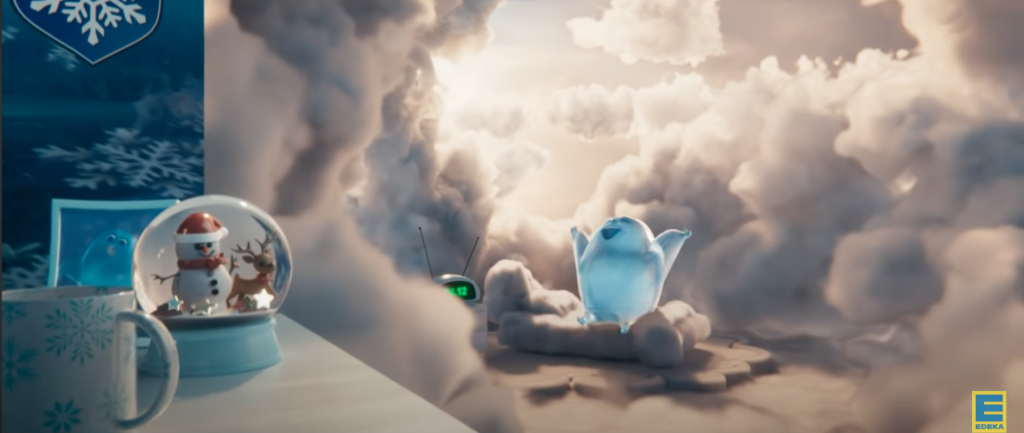
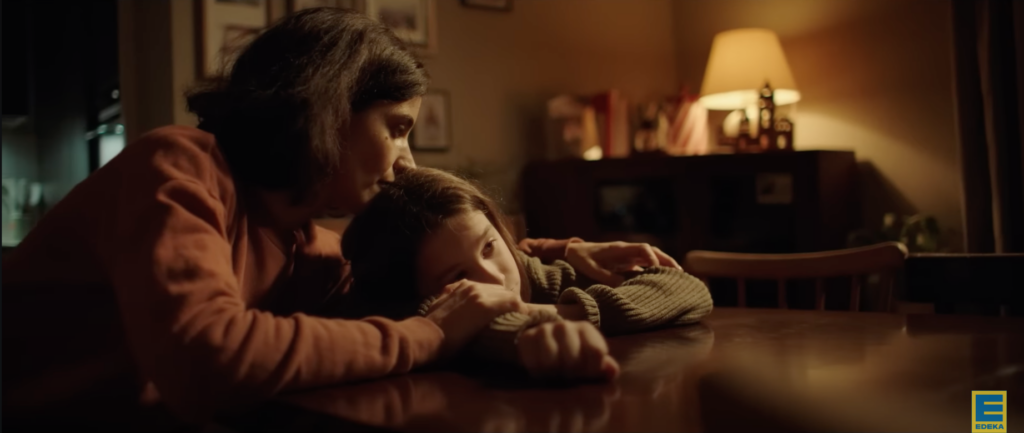
Introduction
For this qualitative content analysis, two video commercials from the german grocery supplier „Edeka“ have been selected. The first one is called „The raindrop that wants to become a snowflake“ and the second one is called „Together it’s going to be a celebration. Firmly promised“ (both titles are translated from german). Both commercials are centered around the theme of Christmas, with the first one released on December 14, 2021, and the second on December 1, 2022. The videos were published on Edeka’s Youtube page, but it is possible that both videos were initially created by an external agency. Edeka posts these videos once a year in December (before the 24th) and is well known for its Christmas commercials in Germany. Every commercial covers a different societal topic, for example in 2020 Edeka reacted to the Covid-19 pandemic, by creating a commercial that centered around helping others during difficult times.
With almost nine million and over ten million views on YouTube, respectively, both of the underlying commercials have been viewed by a significant number of people. Through a textual analysis of these advertisements, I aim to identify their key messages, and cultural and/or social significance, and explore the reasons behind their widespread popularity.
The results of my analysis show that Edeka effectively integrates relevant societal topics into moving short stories, by using typical elements of storytelling and making the viewer emphasize the emotions of the characters in their short stories.
Theoretical Framework
In its initial meaning „analysis“ stands for „loosening up“ or put differently, as in Newman (2020), „taking apart“ a text. Therefore, this analysis will take apart both of the underlying content pieces and will identify the meaning of the content pieces. This includes why they can be considered meaningful in the context of content marketing and which choices have been made in the content to deliver which effect and to whom this is meaningful. As a general guideline for analyzing these content pieces, I am going to use a „Text from The Media Studies Toolkit“ by Newman (2022). This text divides textual analysis into seven different levels: anticipation, experience, description, analysis, interpretation, evaluation, and appropriation. The focus of this textual analysis lies in analyzing and interpreting the content pieces, as the meaning and the way this meaning is transferred to the audience is most interesting in the context of content marketing.
The theoretical framework of this textual analysis mainly builds upon two theories. The first, proposed by Freytag (1863), is a five-step dramatic structure that is commonly found in narratives. The framework includes exposition, rising action, climax, falling action, and resolution (Freytag, 1863). Exposition refers to the introduction of the characters and the setting of the story (Schumann, von Wangenheim, & Groening, 2016). An inciting incident then creates a conflict that has to be solved, followed by rising action (Schumann, von Wangenheim, & Groening, 2016). The story reaches its climax when the viewer is most involved in the story. As the action is falling, the conflict eventually resolves and the story resolutes.
By applying this framework to the two short stories, the analysis can identify the central conflict and its development throughout the narrative, as well as the themes, motifs, and narrative techniques that engage the audience. The second one is the ELM (Elaboration Likelihood Model) Framework, which was developed by Petty and Cacioppo (1984) and describes two different ways of perceiving (media) information: central route processing and peripheral route processing. Central route processing occurs when individuals are motivated and capable of processing information deeply, while peripheral route processing occurs when people are less motivated or unable to process information deeply (Petty & Cacioppo, 1984). By utilizing the ELM framework in this analysis, it will be possible to identify the persuasive strategies employed in the two content pieces and how they influence the audience’s attitudes and behaviors.
Analysis
First video:
The first video advertisement covers an animated story of a raindrop that wants to become a snowflake around Christmas time. But due to warm temperatures fails to do so and finally strikes the window of a house, where a girl is standing behind the window looking outside in the pouring rain. It concludes with the words „We changed the world, now it is time to change us.“. It has a runtime of 1 minute and 24 seconds and is shot in a 16:9 format with letterboxing being used. This creates a typical cinematic look.
The video can be divided into two main sequences. The first sequence follows the journey of „Drip“, the raindrop, as he tries (but ultimately fails) to become a snowflake. The second sequence features the girl standing at the window of her home, where Drip ultimately lands.
Exposition:
The first part of the ad takes place in an animated world situated in the clouds, where Drip lives. Drip represents a child, as shown by his child-like behavior and appearance, with big eyes and a playful demeanor.
The first shot of the story sets the tone with slow, soft piano music accompanied by a warm, deep voice. The comparison to a typical morning routine, with an alarm clock ringing, a radio voice announcing the weather, and Drip stretching his arms after waking up, adds a relatable element to the narrative, which relates to Escalas‘ theory of „self-referencing & persuasion“ (Escalas, 2004). The overall aesthetic creates a light and dreamy atmosphere that draws the viewer into Drip’s world in the clouds, with the comparison to a typical morning enhancing the narrative transportation of the viewer into the action.
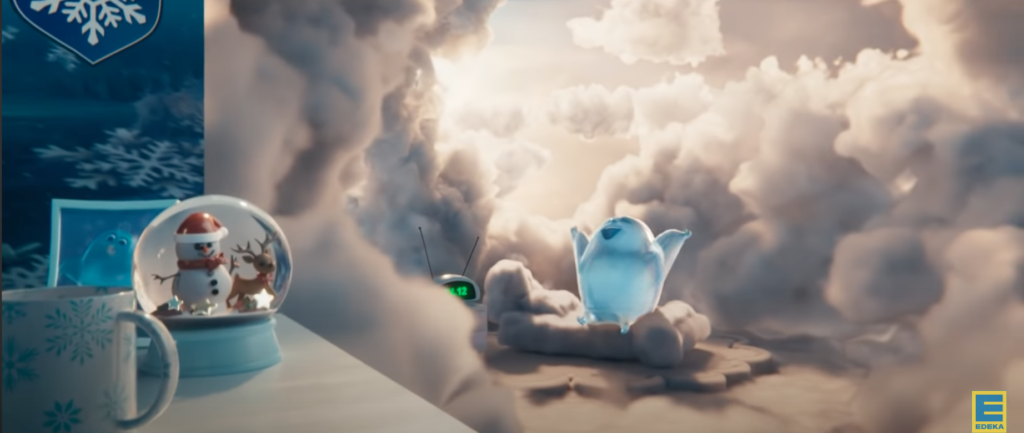
Inciting Incident:
The conflict of the short story is introduced in the first scene, as Drip stands in front of the mirror. Drip drew a snowflake onto the misted mirror and imagines being a snowflake while standing in front of the mirror but then gets disappointed, realizing that he is still a raindrop and does not know when he will become a snowflake.
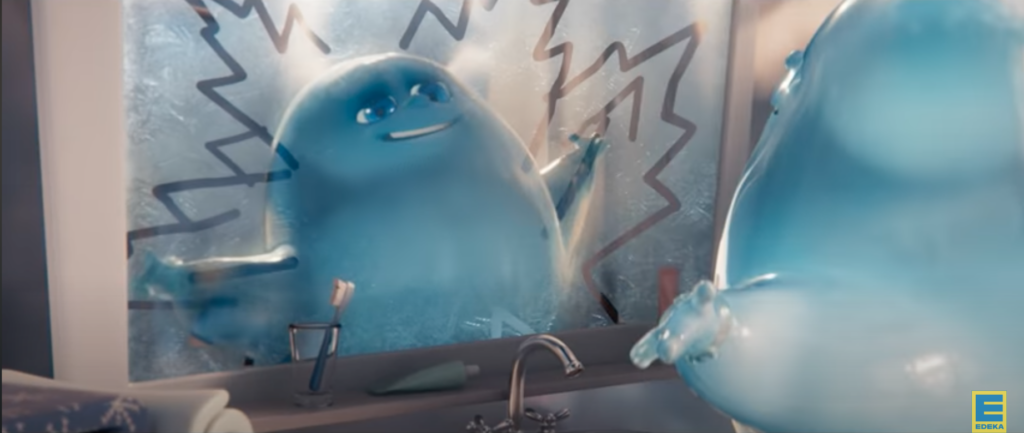
Rising Action:
The next scenes show Drip riding to the snow academy (, which compares to a school, where raindrops learn how to transform into a snowflake) by bus, as he is overwhelmed by the cloud city. This city is constructed of clouds, with streets, houses, and even the snow academy formed from these fluffy shapes.
As Drip enters the Snow Academy the action rises as a signal sounds, indicating that all the raindrops can „jump out of the clouds“ to become snowflakes. However, while other raindrops are running around excitedly, Drip stands still, unsure of what to do. This scene makes the viewer feel compassion for Drip, as he seems helpless and lost. However, when Drip realizes that he is now able to jump the action rises further and the story gets tenser. The music intensifies as all the raindrops enter the „jump zone,“ and Drip becomes more excited when he realizes he can jump. The next scene is emphasized with thunder sound effects and dark, moody visuals as Drip jumps and falls through the clouds. The violin that sets in shortly after Drip jumps out of the clouds adds to the scene’s discomfort and drama.
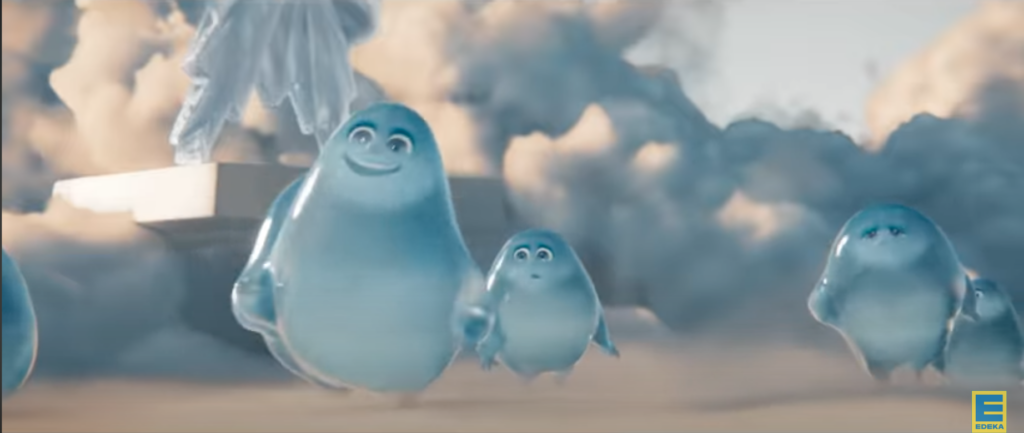
Climax:
Unfortunately, Drip’s watch beeps, indicating that the outside temperature is too high for him to become a snowflake. This represents the climax of the story.
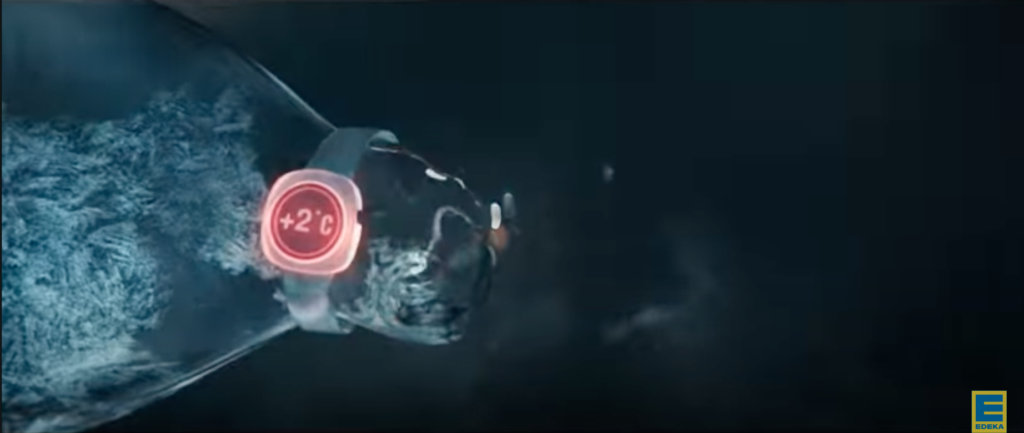
Falling Action:
As Drip gets closer to landing on earth, the video switches between Drip falling and showing the house where he will eventually land. The camera’s fast movement towards the window makes this a point-of-view shot, allowing the viewer to emphasize the action. It becomes clear that Drip is going to strike the window. As the raindrop eventually strikes the window, the girl is standing behind the window and looks at the raindrop running down the window.
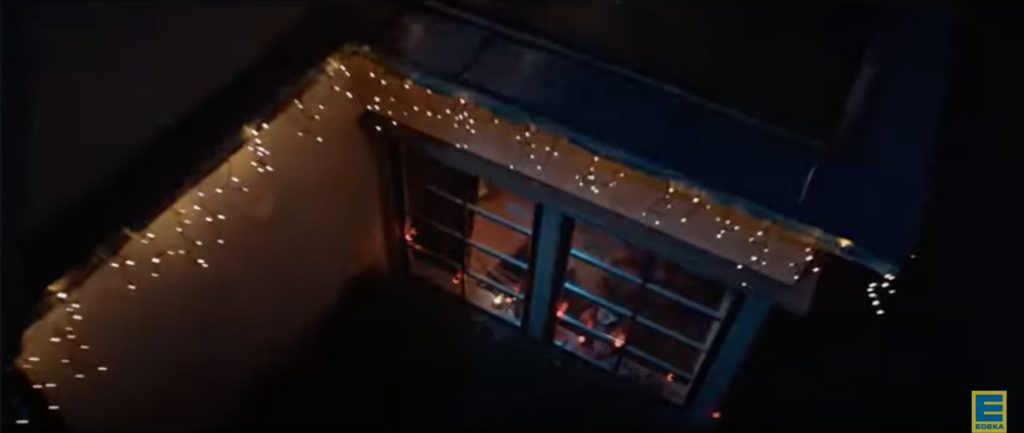
Resolution:
From here on the story is starting to resolve as the next scene shows family members sitting in the house at a table with lots of food, including a roast and side dishes, indicating a typical German Christmas dinner. The warm lighting from the candles and the decorated pine tree also add to the festive atmosphere.
Dénouement:
The video continues again with a shot of the girl standing at the window looking out at the heavy rain pouring from the sky. The video concludes and the story resolutes with the sentence, „We changed the world, now it’s time to change us“ and an Edeka logo.
Second video:
The second video is a short story about a mother and a son that planned to spend Christmas with their family, but as all the family members cancel on them, they decide to organize a Christmas dinner for the local fire brigade. The video was published on Youtube, has a runtime of 2 minutes and 30 seconds, and is shot in a 16:9 format with letterboxing. This creates a typical cinematic look.
Exposition:
The first scene of the video introduces the two characters and their surrounding and represents the exposition of the short story. The scene plays in an old flat or house, which is indicated by wooden parquet and a high ceiling. In the first shot, the mother walks into the living room, where the boy sits on the ground playing with toys. The room is lit up by warm light and the fireplace in the foreground creates a warm, cozy, and homey atmosphere. The wooden interior as well as the fact that the mother and the boy, both are wearing sweaters enhances the cozy vibe. The soft and harmonic piano music supports the homey atmosphere and completes the cozy vibe of the first shot. The story is introduced by the mother telling her son that family (or friends) will come around for Christmas. The boy gets excited about the news and starts playfully hunting his mother as a „Christmas monster“. This also introduces, that the short story takes place around Christmas time. The next shots show their preparations for the upcoming visitors.

Inciting Incident:
The conflict comes up, as the mother gets a text from family members, in which they tell her that they are not going to come to the Christmas dinner. This triggers disappointment in the boy’s eyes and he says „bummer“. The first scene also includes shots of the boy looking outside of the window at a fire brigade that is passing their house. This shot clip implements his excitement for firefighters and builds a reason for the rest of the story.
Rising Action:
The second scene plays later in the evening, but in the same house. The conflict intensifies because other family members also decline the Christmas dinner and eventually nobody is going to come. This is another inciting incident of the story and changes the mood of the video from cheerful to sad. They need to redo all their preparations for the Christmas dinner and eventually sit alone at the empty dining table. This shot (where they sit alone at the table) makes the viewer suffer with the characters.
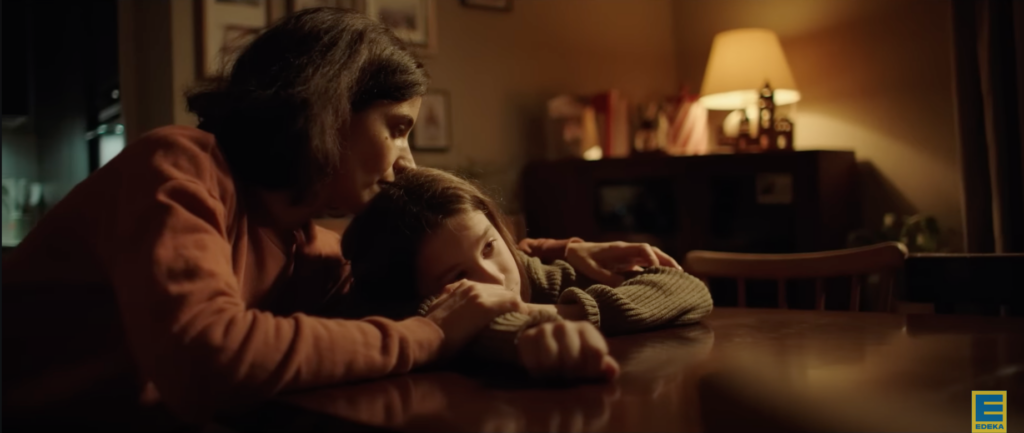
The next scene is a brief scene of the boy sitting in a bus observing, again, a fire brigade. The rather sad mood that is written all over his face is enhanced by the bad weather (thunder and rain) and the overall grey and cold vibe of the scene.
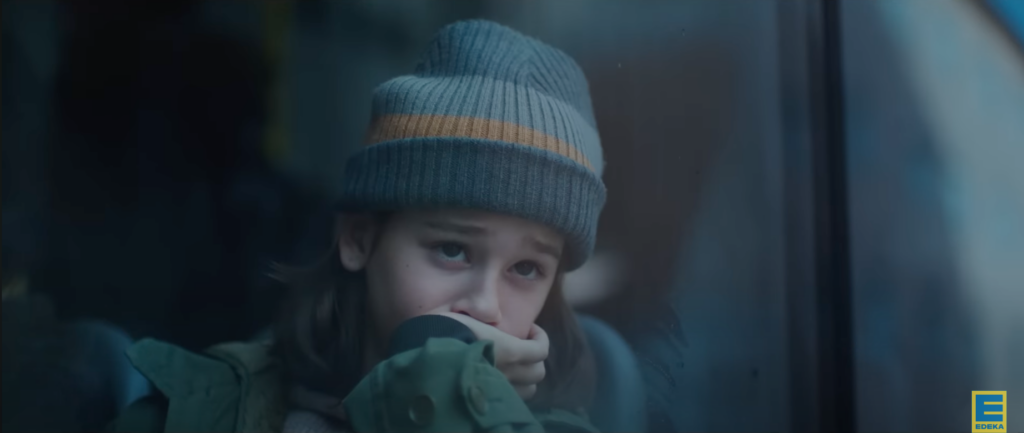
Climax:
The next scene plays in an Edeka supermarket and rapidly changes the mood of the video, as the music becomes cheerful again and the boy happily rides a shopping cart through the (Edeka) supermarket. At this point, the story is at its climax and the conflict seems to get resolved soon. Also, the supermarket scenes are warmer, and fast cut and make the atmosphere exciting and happy and contrasting the previous dark and moody scene.
Falling Action:
The next scene shows the work of a firefighter and his disappointment that he can not be around his family at Christmas. His loneliness is shown by him looking out of the window of the fire truck at a family celebrating Christmas together inside of a house. This introduces a second conflict, the hard-working but lonely firefighter around Christmas.
Resolution:
Finally, the fire truck enters the fire station and the firefighters are surprised by a Christmas dinner, prepared by the boy and his mother. This represents the resolution of the short story and resolves both conflicts. Again the music becomes cheerful, as the boy and his mother are standing in front of the prepared dinner table and the boy says „surprise“ to the firefighters.
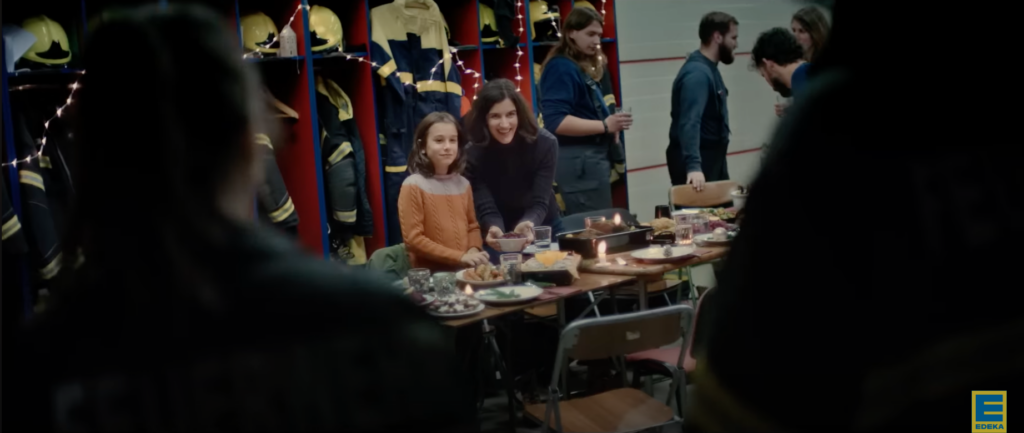
Dénouement:
The rest of the last scene represents falling action, as the dinner starts, the boy is running around with a fire helmet and everybody is having a good time. The message of the story comes with the slogan „It’s going to be a celebration together. Firmly promised.“.
Interpretation
After „taking apart“ the two videos, the next step of the textual analysis is to interpret these two content pieces. This includes pointing out the main message and meaning of the content pieces, while also looking at what effect these content pieces have for EDEKA as a brand and if those videos can be considered meaningful in the context of content marketing. To interpret the effect on the viewer and how this relates to what image EDEKA represents and how the persuades the viewer, the ELM framework will be of some use.
First video:
The message of the first video becomes clear with the last shot when the girl walks away from the window and the words „We changed the world, now it is time to change us.“ appear. These words indicate that Edeka refers to the rising temperatures caused by climate change, and the necessity to change „us“ to limit the negative effects of global warming. The message behind Drip’s story is explained, which is supposed to represent a metaphor for the rising global temperatures, as Drip is failing to become a snowflake due to rising temperatures around Christmas. Edeka speaks directly to the viewer, referring to „us“, who need to change, which makes the message two-fold. On the one hand, Edeka takes on the responsibility to be more sustainable and on the other hand also spreads a message to the viewer, as the story engages the viewer to think about climate change and sustainability.
Hereby, the ad uses several elements of the ELM framework to persuade the viewer. Firstly, it uses the central route to emphasize the conflict that Drip faces and his ultimately unsuccessful attempt to become a snowflake. By creating a relatable and emotionally engaging story, the ad encourages the viewer to think more deeply about climate change and the need for sustainability.
Secondly, the ad uses peripheral cues to persuade. Peripheral cues are mental shortcuts that people use to make decisions when they lack motivation or the ability to process the message deeply. The ad uses music, visual effects, and narrative structure to create a compelling and emotionally engaging story that captures the viewer’s attention. The ad also uses the Edeka logo and the tagline „We changed the world, now it’s time to change us“ as peripheral cues to encourage viewers to take action.
Overall, the first ad effectively uses both central and peripheral routes to persuasion to encourage the viewer to think more deeply about climate change and sustainability and to take action to address these issues.
Edeka’s brand image is centered around promoting sustainable and environmentally conscious practices, therefore the message „We changed the world, now it’s time to change us“ reinforces Edeka’s commitment to promoting sustainable practices and encouraging individuals to take action to reduce their carbon footprint. This aligns with Edeka’s brand image as an environmentally responsible company and emphasizes its dedication to making a positive impact on the environment.
Overall, the ad uses emotional appeals and a relatable story to encourage viewers to take action toward a more sustainable future, while also reinforcing Edeka’s brand image as an environmentally conscious company.
Second video:
The message of the second video is also resolved within the last scene of the video, as the firefighters are being surprised with a festive Christmas dinner made by the mother and her son. The short story highlights the importance of community and spreading joy, especially during the holiday season. Despite the family’s absence, the mother and son decide to share their love and joy with their local fire brigade, who are hardworking and lonely during the holiday season. The act of kindness not only makes the firefighters happy, but it also brings joy to the mother and son.
The final message, „It’s going to be a celebration together. Firmly promised,“ emphasizes the importance of togetherness and celebrating with others. No matter how small or big, acts of kindness and generosity can make a huge difference in people’s lives, and the spirit of the holiday season is about coming together and celebrating the joy of life with those around us.
In this video, the central route of persuasion is used, which involves a high level of elaboration and cognitive processing. The video tells a story that appeals to the viewers‘ emotions and intellect, which encourages them to think deeply about the message and take it seriously. The use of a relatable story helps to create a personal connection with the viewers, which makes the message more relevant and meaningful to them.
The video uses a series of carefully crafted shots, such as the warm and cozy atmosphere in the first scene, the disappointment and sadness on the boy’s face in the rainy bus scene, and the contrast between the dark and moody atmosphere of the boy and his mother sitting alone at the empty dining table and the cheerful atmosphere in the supermarket scene. Finally, it shows the firefighters joyfully entering the fire department as they see the surprising Christmas dinner. These shots are used to evoke emotions and encourage viewers to think deeply about the message.
Overall, the video uses the central route of persuasion by creating a relatable story that appeals to the viewers‘ emotions and intellect, and by using various persuasive techniques to grab and hold their attention until the end.
The image that Edeka tries to achieve with this ad is that of a brand that cares about its customers and the community. The ad portrays Edeka as a brand that not only provides food and other goods but also creates a sense of togetherness and community through its actions. By organizing a Christmas dinner for the local firefighters, the ad shows Edeka as a brand that is socially responsible and cares about the people around them. The ad also promotes the idea of celebrating together and emphasizes the importance of community and social connections. Overall, Edeka tries to position itself as a brand that values people and relationships, not just transactions.
By comparing these two ads, one thing stands out, which is, that both ads cover societal topics. The first video covers sustainability as one of the predominant issues of our time and the second video covers the importance of community and togetherness around Christmas. Both are topics that everybody can relate to, which makes the reach and sharability of those videos high. Also, the target audience of a supermarket, such as Edeka, is usually broad and covers almost every age group. Therefore choosing topics that everybody can relate to, is a good way to reach different age groups and different social groups, fitting the variety of target groups.
Conclusion
In conclusion, both Edeka commercials use different approaches to persuade the viewers and promote the brand’s values. The first video uses emotional appeals and a relatable story to encourage viewers to take action toward a more sustainable future, while also reinforcing Edeka’s brand image as an environmentally conscious company. The second video appeals to the viewers‘ emotions and intellect by telling a relatable story that emphasizes the importance of community and social connections. It positions Edeka as a brand that values people and relationships, not just transactions. Both ads are effective in using the ELM framework to persuade viewers through either central or peripheral routes, and both support Edeka’s brand image as a socially responsible company that cares about its customers and the environment. On the other hand, the brilliant storytelling in both videos communicates these messages in an entertaining way for the audience, which makes both of these videos meaningful in the context of content marketing.
References
EDEKA. (2021, December 14). Der Regentropfen, der eine Schneeflocke werden will | EDEKA Weihnachtswerbung 2021 [The raindrop that wants to become a snowflake | EDEKA Christmas commercial 2021] [Video file]. Retrieved from https://www.youtube.com/watch?
EDEKA. (2022, December 1). EDEKA Weihnachtswerbung 2022: Zusammen wird’s ein Fest. Fest versprochen. [Edeka Christmas commercial 2022: Together it will be a celebration. Promise.] [Video file]. Retrieved from https://www.youtube.com/watch?v=bahWtpQ6eKs
Escalas, J. E. (2004). Imagine yourself in the product: Mental simulation, narrative transportation, and persuasion. Journal of Advertising, 33(2), 37-48. https://doi.org/10.1080/00913367.2004.10639168
Freytag, G. (1863). Technique of the Drama: An Exposition of Dramatic Composition and Art. Breitkopf and Hartel.
Newman, J. (2020). The Media Studies Toolkit: Critical Concepts. Routledge.
Petty, R. E., & Cacioppo, J. T. (1984). The Elaboration Likelihood Model of Persuasion. In L. Berkowitz (Ed.), Advances in Experimental Social Psychology (Vol. 19, pp. 123-205). Academic Press.
Schumann, J. H., von Wangenheim, F., & Groening, C. (2016). Drama goes viral: Effects of story development on shares and views of online advertising videos. Journal of Consumer Psychology, 26(2), 176-188. doi: 10.1016/j.jcps.2015.06.008.